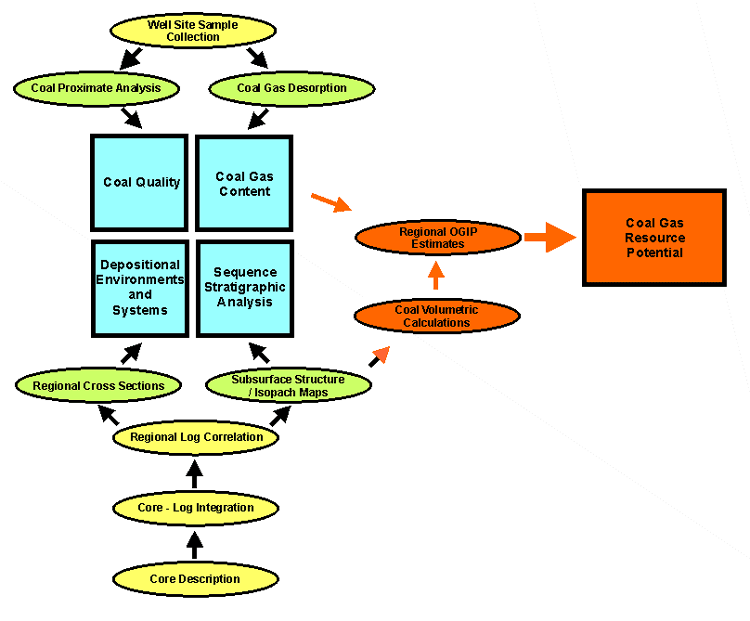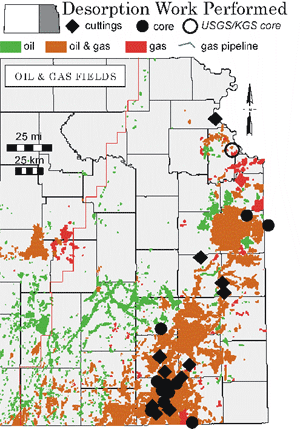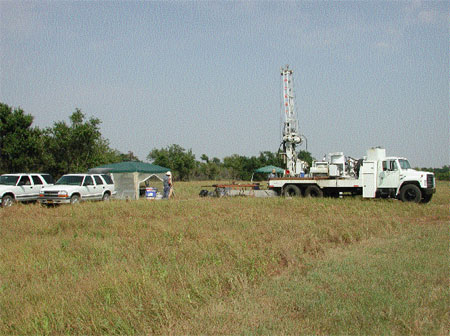 |
|
Kansas Geological Survey Open-file Report 2003-51 |
Stratigraphy, Depositional Environments, and Coalbed Methane Potential of
Pennsylvanian Coals -- Bourbon Arch Region, Eastern Kansas
Troy A. Johnson, Jonathan P. Lange,
Timothy R. Carr and K. David Newell
Timothy R. Carr and K. David Newell
Abstract
The Middle Pennsylvanian Series in eastern Kansas includes thin coal beds (typically less than 0.7m) within siliciclastic and carbonate successions. Across the study area, coal rank ranges from high-volatile A to B bituminous. Coalbed methane has become an active play due to contributing factors such as sufficient overburden, overlying seals of thick shale, the probability of encountering multiple coal beds in a single well, and excellent pipeline infrastructure. A better understanding of coalbed methane potential requires identification of thick (>0.5 m), gas-rich coals in proximity to existing pipelines.
Coal-forming depositional environments were interpreted by integrating core descriptions with well logs to construct cross sections and structure/isopach maps. Coal samples from cores and cuttings were analyzed for methane content and desorption rates, ash and sulfur contents, and other coal properties. Preliminary analysis of numerous coals shows gas contents ranging from 20 to 200 scf/ton between coals and across the Bourbon Arch region. Coal qualities also vary, on a moisture-free basis, from 6% to 50% ash and 1% to 10% sulfur. Coal-bearing successions were interpreted within a sequence stratigraphic framework to develop a better understanding of the lateral variability of coal thickness, quality, and gas content. Possible modern analogues of peat-forming settings for Pennsylvanian coals in eastern Kansas include fluvial or estuarine floodplains, deltaic interdistributaries, coastal strandplains, marshes, and back-barrier marine raised platforms and lowlands. The improved geologic understanding of Pennsylvanian coals should aid in coalbed methane exploration and development in eastern Kansas.
Methods
This study focuses on geologically significant coals with possibly large resource potential in eastern Kansas. Lithologic descriptions and interpretations of several continuous core and accompanying compensated density logs (CDL) serve as the basis for regional correlation of more than 800 other CDL and gamma ray-neutron logs over the area. Subsurface log cross sections, and coal and non-coal isopach and structure maps, permit strata to be depositionally interpreted and placed into a sequence stratigraphic framework. Coal quality and gas desorption data are related to peat-forming environment and sequence stratigraphic position to discern the controls on coalbed gas productivity. Through the use of coal-gas content and quality data, this study assesses potential coalbed gas resources for the Bourbon Arch region of eastern Kansas.

 |
 KGS coring operation in Woodson County, Kansas
KGS coring operation in Woodson County, Kansas |
|
|
e-mail : webadmin@kgs.ku.edu
Last updated October 2003
http://www.kgs.ku.edu/PRS/publication/MidAAPG2003-1/P1-02.html